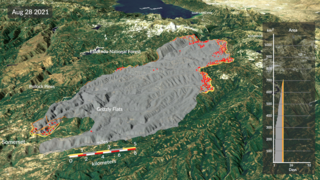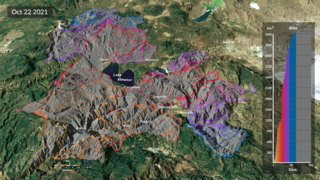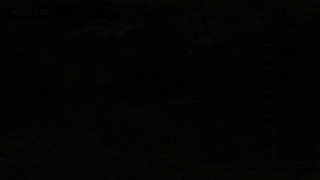Earth
ID: 5088
This visualization highlights data from a new fire detection and tracking approach (Chen et al., 2022) based on near-real time active fire detections from the VIIRS sensor on the Suomi-NPP satellite. Every 12 hours, the fire tracking algorithm uses new active fire detections to update the total fire perimeter and estimate the position of active fire lines where the fire may continue to spread. This approach provides a detailed perspective on the behavior of the Caldor and Dixie fires, identifying periods of rapid fire expansion and active fire detections within the perimeter from continued flaming and smoldering behind the active fire fronts.
The visualization shows the progression over time as the fire spreads. The yellow outlines track the position of the active fire lines every 12 hours for the last 60 hours, with the latest location of the fire front shown in the brightest shade of yellow. The red points show the location of active fire detections within the perimeter, while the grey region shows the estimated total area burned. The graph shows the cumulative burned area in square kilometers.
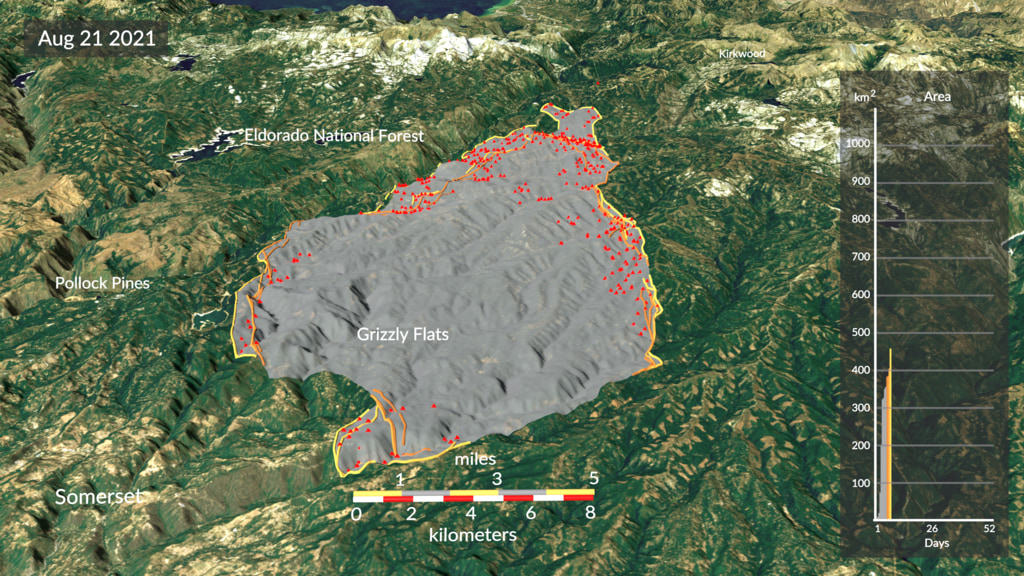
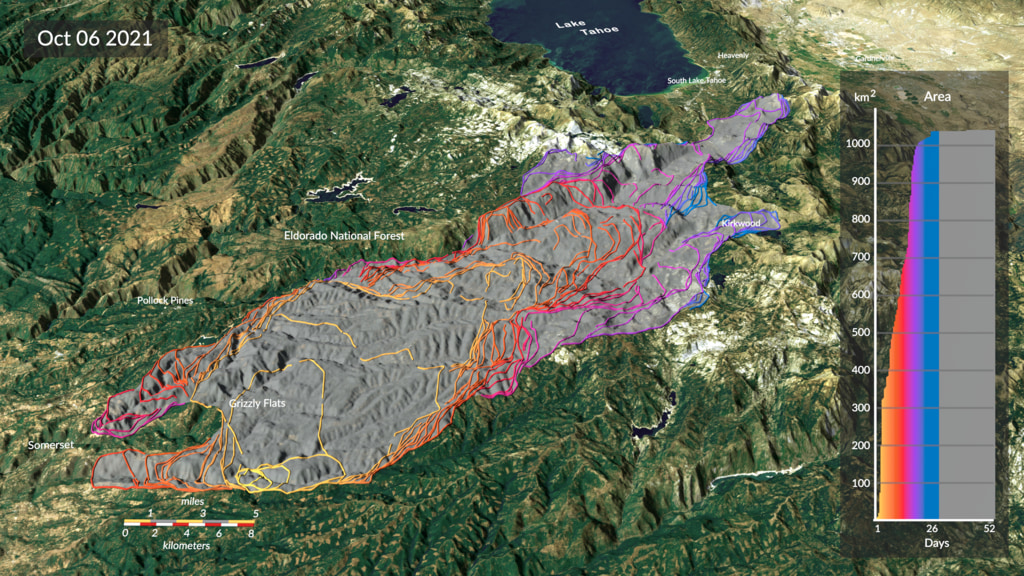
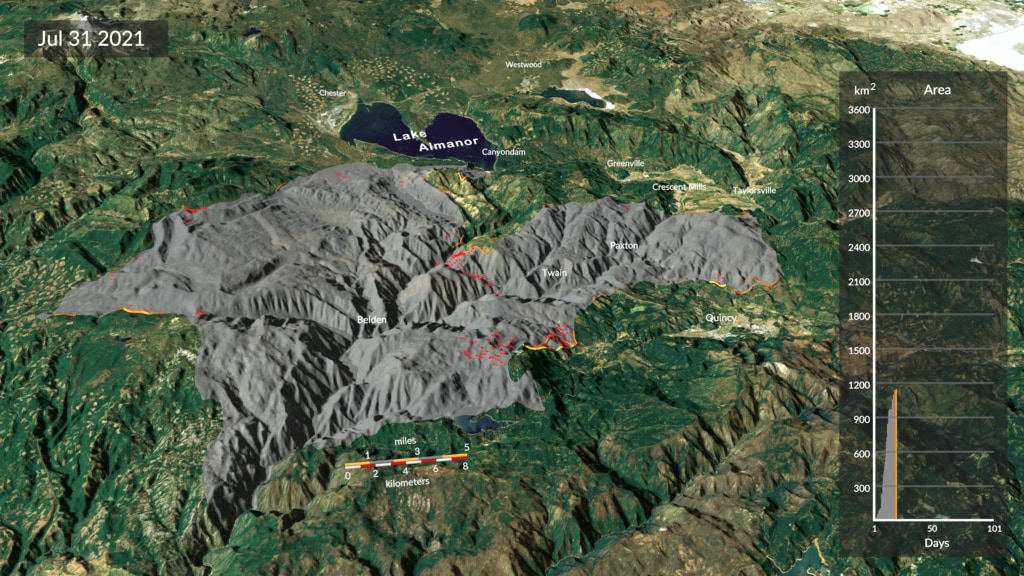
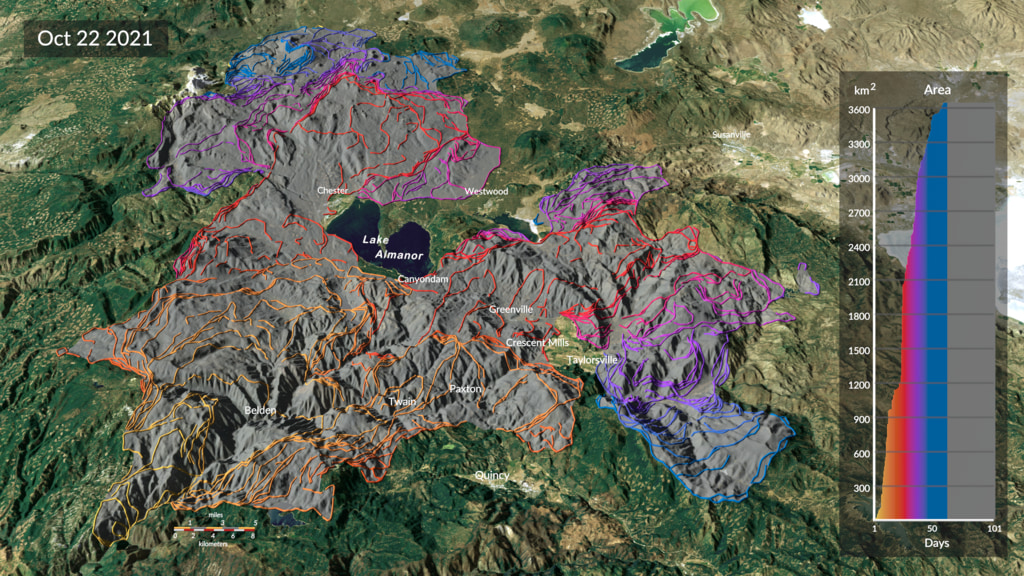
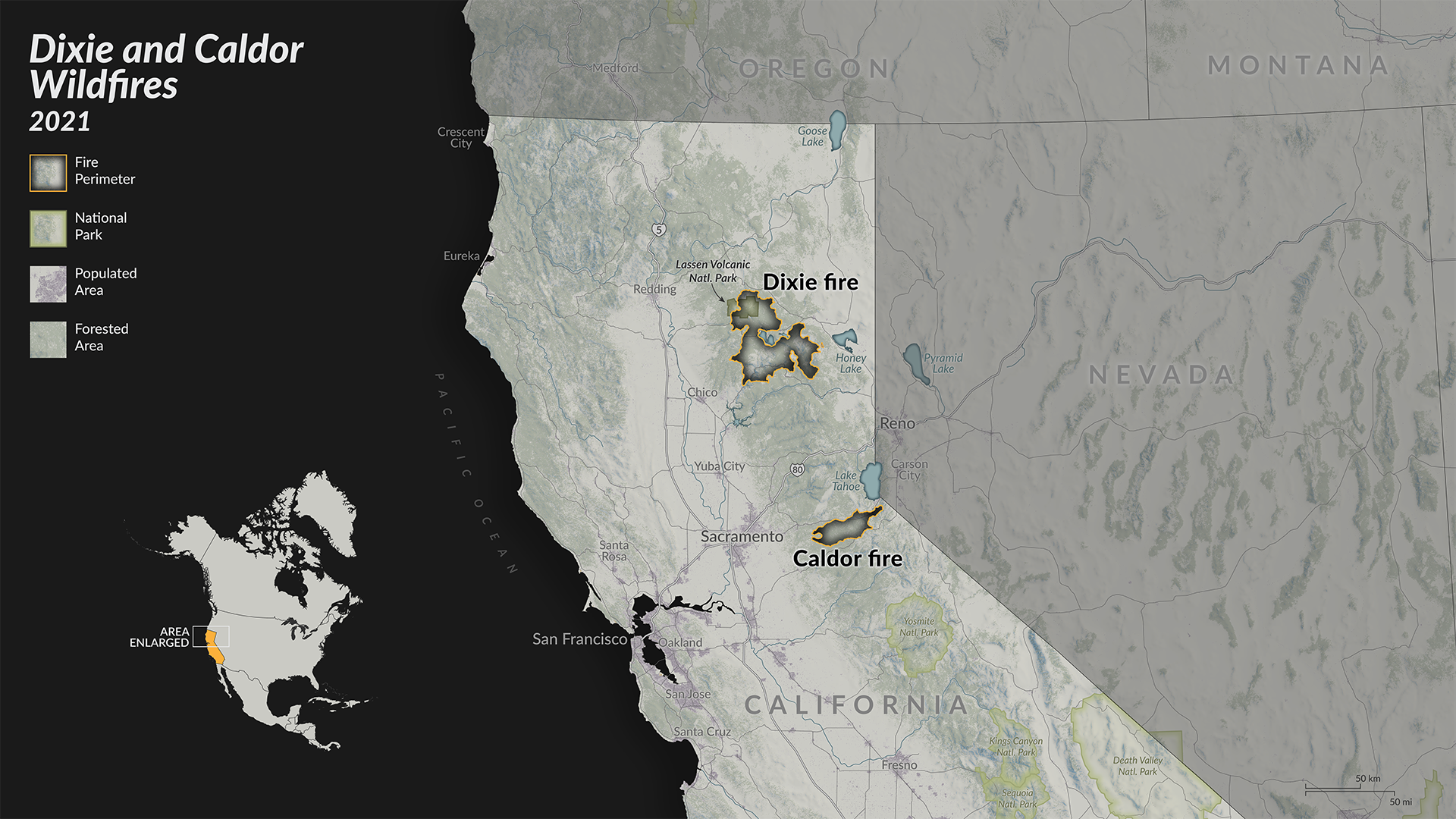
Tracking the Spread of the Caldor and Dixie Fires
The visualization shows the progression over time as the fire spreads. The yellow outlines track the position of the active fire lines every 12 hours for the last 60 hours, with the latest location of the fire front shown in the brightest shade of yellow. The red points show the location of active fire detections within the perimeter, while the grey region shows the estimated total area burned. The graph shows the cumulative burned area in square kilometers.





Source Material
Alternate Version
Visualization Credits
Technical Support:
Ian Jones (ADNET Systems, Inc.)
Laurence Schuler (ADNET Systems, Inc.)
Visualizers:
Kel Elkins (USRA)
Michala Garrison (SSAI)
Greg Shirah (NASA/GSFC)
Horace Mitchell (NASA/GSFC)
Andrew J Christensen (SSAI)
Alex Kekesi (Global Science and Technology, Inc.)
Lead Visualizer:
Cindy Starr (Global Science and Technology, Inc.)
Lead Scientist:
Doug C. Morton (NASA/GSFC)
Ian Jones (ADNET Systems, Inc.)
Laurence Schuler (ADNET Systems, Inc.)
Visualizers:
Kel Elkins (USRA)
Michala Garrison (SSAI)
Greg Shirah (NASA/GSFC)
Horace Mitchell (NASA/GSFC)
Andrew J Christensen (SSAI)
Alex Kekesi (Global Science and Technology, Inc.)
Lead Visualizer:
Cindy Starr (Global Science and Technology, Inc.)
Lead Scientist:
Doug C. Morton (NASA/GSFC)
Please give credit for this item to:
NASA's Scientific Visualization Studio
NASA's Scientific Visualization Studio
Science Paper:
Chen, Y., Hantson, S., Andela, N. et al. California wildfire spread derived using VIIRS satellite observations and an object-based tracking system. Sci Data 9, 249 (2022). https://doi.org/10.1038/s41597-022-01343-0
Short URL to share this page:
https://svs.gsfc.nasa.gov/5088
Data Used:
Note: While we identify the data sets used in these visualizations, we do not store any further details nor the data sets themselves on our site.
This item is part of this series:
Narrated Movies
Keywords:
SVS >> Fire Management
DLESE >> Human geography
DLESE >> Natural hazards
GCMD >> Earth Science >> Human Dimensions >> Natural Hazards >> Fires
SVS >> Hyperwall
SVS >> Biosphere >> Ecological Dynamics >> Fire Occurrence
NASA Science >> Earth
GCMD >> Earth Science >> Human Dimensions >> Environmental Governance/management >> Fire Management
GCMD keywords can be found on the Internet with the following citation: Olsen, L.M., G. Major, K. Shein, J. Scialdone, S. Ritz, T. Stevens, M. Morahan, A. Aleman, R. Vogel, S. Leicester, H. Weir, M. Meaux, S. Grebas, C.Solomon, M. Holland, T. Northcutt, R. A. Restrepo, R. Bilodeau, 2013. NASA/Global Change Master Directory (GCMD) Earth Science Keywords. Version 8.0.0.0.0
Chen, Y., Hantson, S., Andela, N. et al. California wildfire spread derived using VIIRS satellite observations and an object-based tracking system. Sci Data 9, 249 (2022). https://doi.org/10.1038/s41597-022-01343-0
Short URL to share this page:
https://svs.gsfc.nasa.gov/5088
Data Used:
SRTM/SIR-C/DEM
Landsat-8/OLI/TIRS/Band Combination 4-3-2
Observed Data - USGS - 07/11/2021Suomi-NPP/VIIRS/California Wildfire Spread Derived using VIIRS Observations and an Object-based Tracking System also referred to as: California Wildfire Spread Derived using VIIRS Observations and an Object-based Tracking System
08/15/2021 - 10/06/2021
Credit:
Chen, Yang; Hantson, Stijn; Andela, Niels; Coffield, Shane; Graff, Casey; Morton, Douglas C.; et al. (2022): A Dataset of California Wildfire Spread Derived Using VIIRS Observations and an Object-based Tracking System. figshare. Collection. https://doi.org/10.6084/m9.figshare.c.5601537.v1
Chen, Yang; Hantson, Stijn; Andela, Niels; Coffield, Shane; Graff, Casey; Morton, Douglas C.; et al. (2022): A Dataset of California Wildfire Spread Derived Using VIIRS Observations and an Object-based Tracking System. figshare. Collection. https://doi.org/10.6084/m9.figshare.c.5601537.v1
This item is part of this series:
Narrated Movies
Keywords:
SVS >> Fire Management
DLESE >> Human geography
DLESE >> Natural hazards
GCMD >> Earth Science >> Human Dimensions >> Natural Hazards >> Fires
SVS >> Hyperwall
SVS >> Biosphere >> Ecological Dynamics >> Fire Occurrence
NASA Science >> Earth
GCMD >> Earth Science >> Human Dimensions >> Environmental Governance/management >> Fire Management
GCMD keywords can be found on the Internet with the following citation: Olsen, L.M., G. Major, K. Shein, J. Scialdone, S. Ritz, T. Stevens, M. Morahan, A. Aleman, R. Vogel, S. Leicester, H. Weir, M. Meaux, S. Grebas, C.Solomon, M. Holland, T. Northcutt, R. A. Restrepo, R. Bilodeau, 2013. NASA/Global Change Master Directory (GCMD) Earth Science Keywords. Version 8.0.0.0.0
